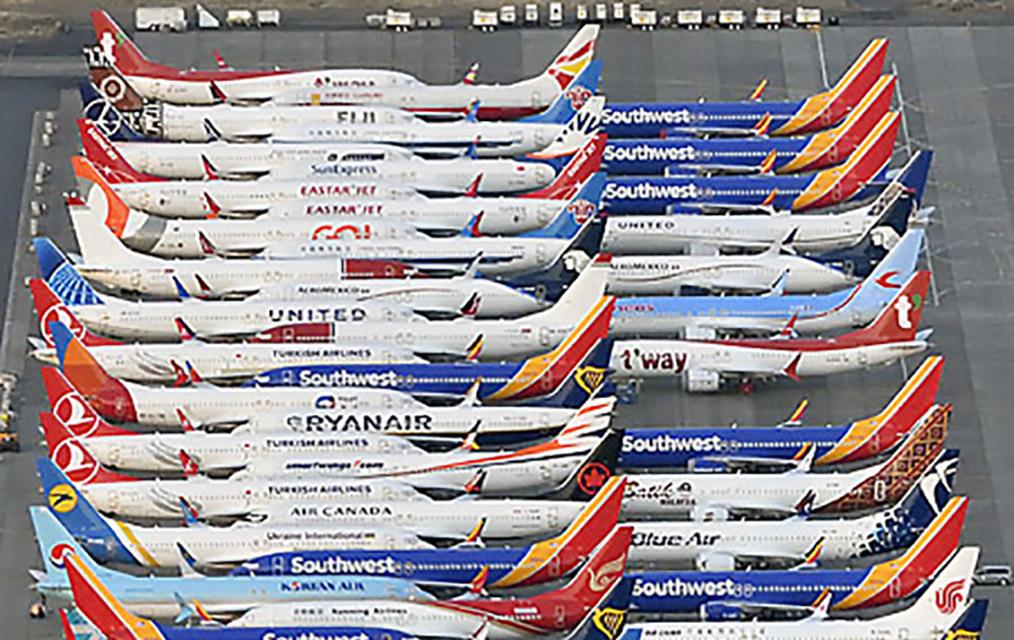Boeing Will Halt MAX Production In January As Grounding Drags On
Sean Broderick Michael Bruno Guy Norris December 16, 2019
Credit: Mark Wagner
Boeing, citing “uncertainty” in when the 737 MAX will be cleared to return to service as a key factor, will suspend 737 production in January 2020, the company said Dec. 16.
The production halt, the second in the 737 program’s 53-year history, will stop the build-up of undelivered MAXs that now numbers about 400 since the model was grounded in mid-March following its second fatal accident in five months. Boeing halted deliveries immediately after the groundings and cut 737 production to 42 from 52 in April.
Boeing says that once the MAX is cleared to return, it will prioritize clearing the backlog of stored aircraft, suggesting that a production resumption will not come in lock-step with regulatory approval.
“We will continue to assess our progress towards return-to-service milestones and make determinations about resuming production and deliveries accordingly,” the company said.
A tweet from the Society of Professional Engineering Employees in Aerospace union that represents the affected production-line workers said the shutdown will “last weeks” and that “no end-date” has been identified. It also confirmed that no layoffs are planned.
Boeing for months had been confident that the MAX would win FAA approval to return in the 2019 fourth quarter, clearing the way for deliveries to resume perhaps as early as this month. But the company cautioned that any slippage in that timeline could cause it to re-evaluate its production plans.
Over the last several weeks, it became clear that approving the software and its documentation as well as finalizing new training for MAX pilots would stretch into 2020. Adding to the logistical challenge: regulatory approvals will come in phases, as some agencies validate Boeing’s changes themselves, beyond what the FAA is doing.
Airlines estimate they need at least a month following their regulators’ approval to start re-integrating MAXs, meaning the earliest that MAXs will operate revenue flights is sliding into the 2020 second quarter. With airlines unable to use MAXs for at least another three months, Boeing decided that not making any more is the best course of action.
“We believe this decision is least disruptive to maintaining long-term production system and supply chain health, Boeing said. “This decision is driven by a number of factors, including the extension of certification into 2020, the uncertainty about the timing and conditions of return to service and global training approvals, and the importance of ensuring that we can prioritize the delivery of stored aircraft.”
Boeing said affected workers “will continue 737-related work or be temporarily assigned to other teams in Puget Sound.” Boeing has been building up a temporary team at its Moses Lake, Washington facility to help prepare stored aircraft for delivery once regulatory approvals begin.
About 3,000 of Boeing’s Renton, Washington facility are involved 737 MAX production. The production pause does not affect the P-8 Poseidon program.
At the same time as opting for the MAX production halt, Boeing’s board declared a regular quarterly dividend of $2.055 per share. The dividend was in line with expectations that Wall Street had into early December, before it became clear the MAX would not be approved in 2020 and production would pause.
The fact that Boeing chose to maintain issuing a dividend while halting production was expected. “You have a conservative CFO here [at Boeing] who’d like to save that cash on the balance sheet,” analyst Sheila Kahyaoglu of Jefferies said of Boeing CFO Greg Smith.
Every month at 42/month production equates to $1.5 billion of inventory carrying costs per month or $4.4 billion per quarter, assuming essentially no advances. The dividend consumes $4.7 billion of cash per year. “I think you have to halt production to keep the dividend,” Kahyaoglu said.
Boeing took a $4.9 billion 2019 second-quarter charge for anticipated charges related to the MAX grounding, including payments to customers. It plans to provide an update as part of its fourth-quarter earnings release next month.
January’s shutdown will come about 11 years after the only other 737 production halt. An eight-week strike by 27,000 members of the International Association of Machinists starting in September 2008 cost Boeing $1.8 billion and affected all models in production.
Ramp-ups of its then-new 737 Next Generation and 747-400 created production-line chaos in 1997. Boeing halted the 747 line and slowed the 737 line by not introducing any new aircraft for 25 days. The slowdown cost Boeing about $2.6 billion, including $1.6 billion in late deliveries and production-recovery costs. It also reduced Boeing’s full-year 737 delivery total by 105 airframes, to 375.



Ingen kommentarer:
Legg inn en kommentar
Merk: Bare medlemmer av denne bloggen kan legge inn en kommentar.